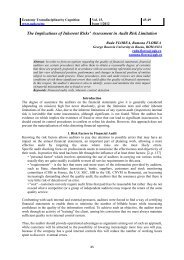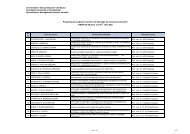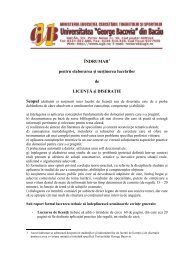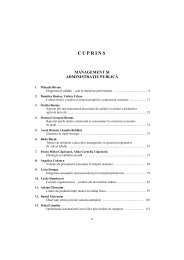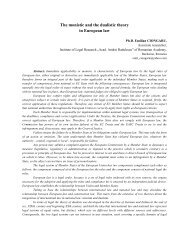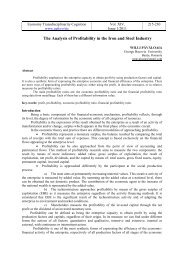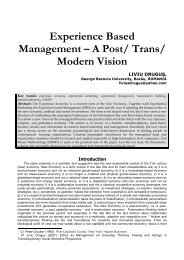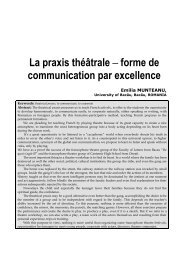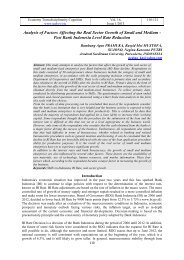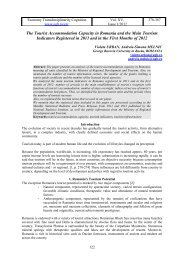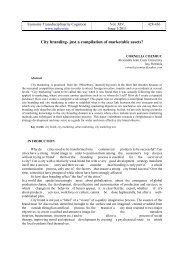BULETIN ÄTIIN IFIC - Universitatea George Bacovia
BULETIN ÄTIIN IFIC - Universitatea George Bacovia
BULETIN ÄTIIN IFIC - Universitatea George Bacovia
Create successful ePaper yourself
Turn your PDF publications into a flip-book with our unique Google optimized e-Paper software.
Shaping the practical role of a transdisciplinary higher education 31<br />
<br />
<br />
In order to better explain their new approach to the triadic transaction among<br />
education, education policy and business, the authors start from a new vision/paradigm of<br />
human existence based on two fundamental features of reality. On the one hand, there is<br />
the continuous existence of reality (thinking and acting included) and on the other hand,<br />
there is the permanent and simultaneous flow of information, communication, interaction/<br />
transaction between/ among all possible concrete (images of) levels of reality shaped by<br />
(the cultural framework of) every individual. These two fundamental features should not be<br />
confused. Even if, at first sight, they seem to be very similar, we underline the fact that the<br />
former one (the continuous dimension of human existence) is derived from a spatial<br />
dimension, whereas the latter one (the permanent flow of interactions among levels of<br />
reality) is derived from the temporal dimension of human existence.<br />
The interaction between the continuous space and the permanent and simultaneous<br />
flow of transactions generates the transdisciplinary approach which happens in space and<br />
time as a reality with a higher degree of complexity. When the modern thinking began to<br />
study reality, it divided it into discrete forms called sciences/ disciplines/ specializations<br />
with the negative result of lack of communication among all these scientific disciplines. As<br />
a consequence, human mind (which functions as continuous processes, not discrete ones)<br />
refused to accept this segmentation. This refusal created a new way of thinking, the socalled<br />
postmodern or transmodern thinking forms 1 of existence: for example, trandisciplinarity,<br />
transdevelopment and transnational political realities. In education (i.e. the<br />
process of communicating different ways of understanding the reality and of transforming it<br />
according to different criteria) this transition from a paradigm to another took different<br />
forms, such as: learning by doing, learning by acting, action learning, learning by sharing,<br />
experiential learning 2 etc.<br />
The general concept of teaching is changed into a more general one of learning and<br />
thus, the focus being transferred from the teacher to the student. This was a very<br />
important stage in the development of education that prepared another one, namely the<br />
transfer from student focused education to graduate focused education. This means a real<br />
continuum of pedagogical skills which are simultaneously focused on the student and on<br />
the graduate; which is, after all, a real challenge for (higher) education nowadays. The<br />
authors of this paper do believe that the higher education process needs a radical<br />
transformation determined by the new and future levels of reality.<br />
This challenge is very well-served by the transdisciplinary approach 3 , and a quite<br />
concrete application of this is EMMY 4 . At the moment, the authors apply this scientific tool<br />
<br />
<br />
<br />
1 After some decades of debating on the usefulness or unusefulness of postmodern thinking, in the last years<br />
the positive and generally accepted contributions of postmodern thinking have been gathered under the<br />
name of transmodern thinking.<br />
2 Each of these forms of learning/ teaching has its advantages and disadvantages, but the most important<br />
thing is to fit one or another to the concrete objectives of the society where they are applied to. As a matter of<br />
fact, this matching could be a result of applying EMMY (ends matched to means).<br />
3 The theory on trandisciplinarity, developed by Basarab Nicolescu, “concerns that which is at once between<br />
the disciplines, across the different disciplines, and beyond all discipline” and characterized by three<br />
features: the logic of the included third; levels of reality; complexity. For more information on<br />
transdisciplinarity, the following book and paper are fundamental: Basarab, Nicolescu, A Manifesto of<br />
Transdisciplinarity, State University of New York, New York, SUNY Press, 2002; The Transdisciplinary<br />
Evolution of the University. Condition for Sustainable Development and Basarab Nicolescu, The<br />
transdisciplinary evolution of learning, http://www.unesco.org/education/educprog /lwf/dl/nicolescu_f.pdf<br />
4 EMMY is a transdiciplinary approach on human being, human existence and human thinking, based on<br />
three former disciplines: politics, economics, ethics. In EMMY’s terminology, all this is, as a matter a fact, a<br />
continuum of ends, means and their permanent matching. Of course, psychology, sociology, anthropology,



